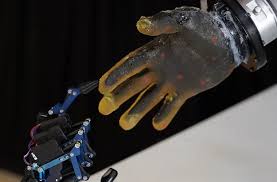– Commercial –
Washington DC [US], June 17: Scientists from the College of Cambridge and College Faculty London (UCL) have developed a revolutionary robotic pores and skin that brings machines considerably nearer to replicating the complexity of human contact.
Additionally learn: Live Struggle Updates: Iranian Missile Strikes Youngsters’s Middle In Beersheba, IDF Warns of Extended Battle
Crafted from a versatile, low-price, gel-like materials, this new pores and skin transforms your complete floor of a robotic hand into a wise, responsive sensor able to detecting stress, temperature, ache, and a number of factors of contact concurrently. Not like typical robotic skins that depend on a mix of a number of, particular person sensors, this innovation integrates sensing capabilities throughout your complete materials — very similar to human pores and skin.
The gel-based mostly, conductive materials might be simply fabricated, melted down, and reshaped into quite a lot of complicated kinds. Researchers say this makes it a flexible and scalable answer, with broad potential throughout a number of industries.
– Commercial –
Although not but as delicate as pure pores and skin, the robotic pores and skin accommodates over 860,000 microscopic sign pathways, permitting it to interpret numerous tactile inputs akin to a finger faucet, excessive temperatures, harm from sharp objects, or multi-level contact — all inside a single materials.

To reinforce its sensory skills, the analysis group used machine studying to assist the pores and skin ‘study’ which pathways reply most successfully to particular forms of bodily interactions, boosting its effectivity and accuracy.
Lead researcher Dr. David Hardman from Cambridge’s Division of Engineering defined, “Having completely different sensors for various kinds of contact results in supplies which might be complicated to make. We needed an easier, extra unified answer.”
Dr. Thomas George Thuruthel of UCL, co-writer of the examine, added, “On the similar time, we’d like one thing that’s low-cost and sturdy, in order that it’s appropriate for widespread use.”
The breakthrough, revealed in Science Robotics, paves the best way for main developments in humanoid robotics, prosthetics, and even industrial functions akin to automotive manufacturing and catastrophe restoration, the place tactile sensitivity might be essential.
Future efforts will deal with enhancing the pores and skin’s sturdiness and testing its performance in actual-world robotic operations.
